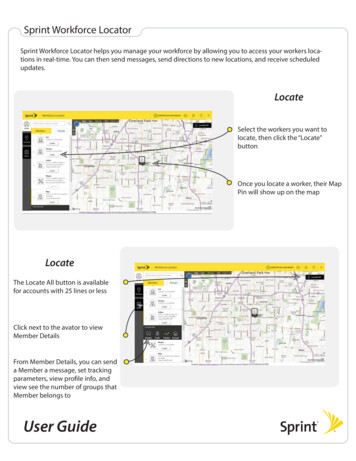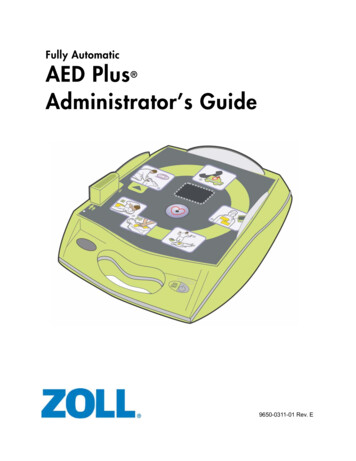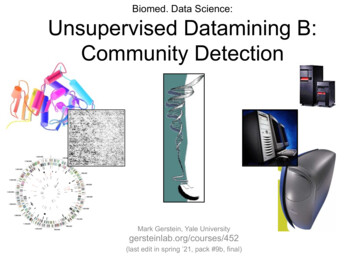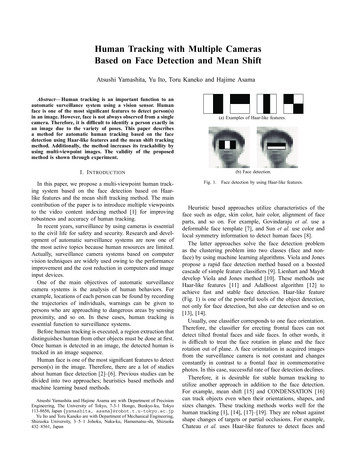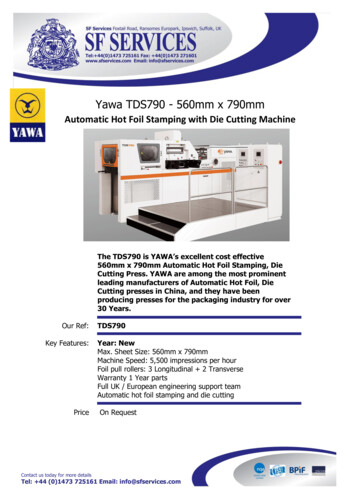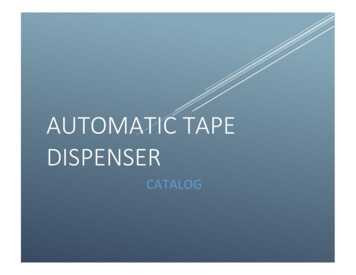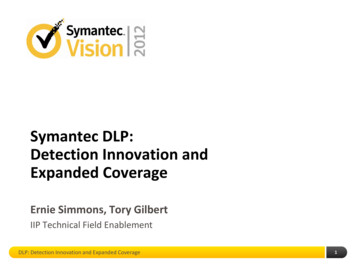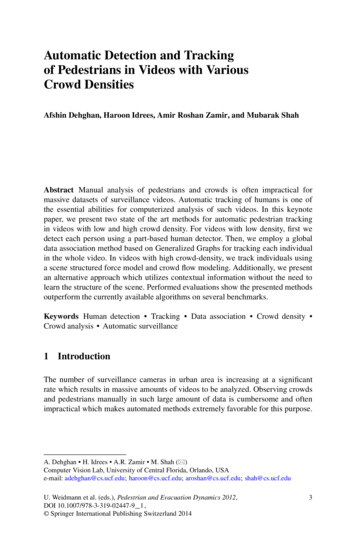
Transcription
Automatic Detection and Trackingof Pedestrians in Videos with VariousCrowd DensitiesAfshin Dehghan, Haroon Idrees, Amir Roshan Zamir, and Mubarak ShahAbstract Manual analysis of pedestrians and crowds is often impractical formassive datasets of surveillance videos. Automatic tracking of humans is one ofthe essential abilities for computerized analysis of such videos. In this keynotepaper, we present two state of the art methods for automatic pedestrian trackingin videos with low and high crowd density. For videos with low density, first wedetect each person using a part-based human detector. Then, we employ a globaldata association method based on Generalized Graphs for tracking each individualin the whole video. In videos with high crowd-density, we track individuals usinga scene structured force model and crowd flow modeling. Additionally, we presentan alternative approach which utilizes contextual information without the need tolearn the structure of the scene. Performed evaluations show the presented methodsoutperform the currently available algorithms on several benchmarks.Keywords Human detection Tracking Data association Crowd density Crowd analysis Automatic surveillance1 IntroductionThe number of surveillance cameras in urban area is increasing at a significantrate which results in massive amounts of videos to be analyzed. Observing crowdsand pedestrians manually in such large amount of data is cumbersome and oftenimpractical which makes automated methods extremely favorable for this purpose.A. Dehghan H. Idrees A.R. Zamir M. Shah ( )Computer Vision Lab, University of Central Florida, Orlando, USAe-mail: adehghan@cs.ucf.edu; haroon@cs.ucf.edu; aroshan@cs.ucf.edu; shah@cs.ucf.eduU. Weidmann et al. (eds.), Pedestrian and Evacuation Dynamics 2012,DOI 10.1007/978-3-319-02447-9 1, Springer International Publishing Switzerland 20143
4A. Dehghan et al.Automatic tracking of pedestrians is one of the required abilities for computerizedanalysis of such videos.The density of pedestrians significantly impacts their appearance in a video. Forinstance, in the videos with high density of crowds, people often occlude each otherand usually few parts of the body of each individual are visible. On the other hand,the full body or a significant portion of the body of each pedestrian is visible invideos with low crowd-density. These different appearance characteristics requiretracking methods which suite the density of the crowd. In this paper, we present twostate of the art methods for tracking pedestrians in videos with low and high densityof crowds.For videos with low density of pedestrians (Sect. 2), first we detect individualsin each video frame using a part-based human detector which efficiently handlesocclusion (Sect. 2.1). Later, we employ a global data association method based onGeneralized Minimum Clique Graphs for tracking each person over the course ofthe whole video (Sect. 2.2).We present two approaches to tracking for videos with high density of crowds.In the first one, the scene layout constraint which is captured by learning DynamicFloor Field, Static Floor Field and Boundary Floor Field along with crowd flowis leveraged to track individuals in the crowd. In the second approach, no learningor crowd flow is used to track targets. Instead, the tracking is performed utilizingsalient and contextual information.2 Pedestrian Tracking in Videos with Low Crowd DensityOur framework for tracking pedestrians in videos with low density of crowdsconsists of two main steps: Human Detection (Sect. 2.1) and Data Association(Sect. 2.2):2.1 Part-based Human DetectionHuman detection is a fundamental problem in video surveillance. Robust humantracking is highly dependent on reliable detection in each frame. Although humandetection has been well studied in computer vision, most of the existing approachesare unsuitable for detecting targets with large variance in appearance. Therefore,robust human detection remains a challenge due to the highly articulated bodypostures, occlusion, background clutter and viewpoint changes.
Automatic Detection and Tracking of Pedestrians in Videos with Various Crowd. . .5Fig. 1 (a) A sample positive image and its HOG descriptor. (b) Left: detections obtained usingpart-based human detector in [6]. Right: a model for root and parts and a spatial model for thelocation of each part relative to the rootMany approaches have been proposed for human detection over the last decade.In most of them, the problem is formulated as a binary sliding window classification,i.e. an image pyramid is constructed and a fixed size window is scanned over all ofits levels to localize humans using a non-maximum suppression procedure.Dalal and Triggs [5] use HOG as low a level feature which is shown tooutperform other competitive features, such as wavelets, for human detection.HOG provides a robust feature set that allows the human body to be distinguisheddiscriminatively even in cluttered background. The descriptor purposed by Dalal andTriggs computes an edge oriented histogram on a dense grid of uniformly spacedcells. Then, they use overlapping local contrast normalizations in order to improvethe overall performance. A linear SVM classifier is used to learn a model for thehuman body using positive and negative samples. The detector is then applied tothe image to localize human bodies, i.e. the detector takes an image, a positionwithin that image and a scale as the inputs and determines if there is a person in thatparticular location and scale. Figure 1a shows a sample positive image and its HOGdescriptor.Using local features to learn body parts is another approach to human detection.Part-based approaches which model an object as a rigid or deformable configurationof parts are shown to be very effective for occlusion handling. Felzenszwalb et al. [6]simultaneously learn parts and an object model. Their model is an enriched versionof Dalal and Triggs’ which uses a star structured part-based model defined by a rootfilter plus a set of parts associated using a deformation model. The score associatedto each star model is the summation of the scores of the root filter and parts at agiven location and scale minus a deformation cost which measures the deviation ofparts from their ideal location relative to the root. The scores of both parts and rootare defined as the dot product of a learnt filter which belongs to that part and a setof extracted features for that specific location. The same set of features as [5], i.e.HOG, is used in [6] with the difference that principle component analysis has beenapplied to HOG features in order to reduce the dimensionality.
6A. Dehghan et al.Fig. 2 Left: human detection results using [6]. Right: human detection results using our approachwhere red boxes show the human detected as full bodies, green boxes show the humans detected asupper bodies, and yellow boxes show the humans detected as heads only. It is clear that [6] failedto detect occluded humans since it does not have an explicit occlusion model, while our approachdetects the occluded parts and excludes them from the total detection scores, thus achievingsignificant improvements especially in crowded scenes2.1.1 Human Detection with Occlusion HandlingWhile the deformable part-based model has recently shown excellent performancein object detection, it achieves limited success when the human is occluded. Inparticular, the final score in [6] is computed using the score of all the parts withoutconsidering that some of them can be occluded by other pedestrians or static objectsin the scene. The occlusion happens especially in crowded scenes such as theexample shown in Fig. 2 which signifies the drawback of this method. Consideringthe score of the occluded parts in the final decision score may cause the algorithmto ignore most of the partially occluded humans in the final detection results.Therefore, some methods such as [7] or [8] rely on head detection only and disregardthe rest of the body.To address this problem, we purpose in [9] to infer occlusion information fromthe score of the parts and utilize only the ones with high confidence in theiremergence. By looking at the score of each part, we find the most reliable set ofparts that maximizes the probability of detection. Let H denote the HOG featureof the image, and p D (x,y) represent the location of a part. The detection score atlocation (x0 ,y0 ) defined in [6] is:score .x0 ; y0 / D b Ci DnXs .pi / ;i D1where b is the bias term, n is the number of parts, and s(pi ) is the score of part iwhich is computed as: s .pi / D Fpi :¿ .H; pi / dpi :¿d dx ; dy ;where Fpi is the part filter, and ¿ (H,pi ) denotes the vector obtained by concatenating the feature vectors from H at the sub window of the part pi (dx ,dy ) denotesthe displacement of the parts with respect to the anchor position. To address the
Automatic Detection and Tracking of Pedestrians in Videos with Various Crowd. . .7discussed issue, instead of aggregating the score of all the parts, we select the subsetof parts which maximize the detection score:score .x0 ; y0 / D b C argmaxSmX11: jSm j i 2S 1 C exp .A .pi / :s .pi / C B .pi //mThe sigmoid function is introduced to normalize the score of the parts. Theparameters A and B are learned by the sigmoid fitting approach and jSm j is the setcardinality. This equation corresponds to the average score of the parts in a subsetwhich makes the comparison between different subsets easy.If there is an occluded part in a subset jSm j, its average score will be lower thana case which doesn’t have any occluded parts. Therefore, by maximizing the aboveequation, we obtain the most reliable set of parts and its corresponding detectionscore. In our experiments we consider only three subsets of parts (full body, upperbody and head only). We found these three subsets to be representative enough formost scenarios. That way, we do not need to search for all the 2n parts. Figure 2demonstrates the qualitative comparison between [6] and our approach.2.2 Data Association Using Generalized GraphsThe method explained in Sect. 2.1 detects humans in each video frame. However, itdoes not specify which detections belong to one identity. We need to determinethe detections which correspond to one particular pedestrian in order to form atrajectory. We employ a data association method based on Generalized MinimumClique Problem (GMCP) for this purpose. The input to the data association methodis the detections obtained using the human detector of Sect. 2.1, and the output isthe trajectory of each pedestrian in the video. Figure 3 shows the block diagram ofthis process. First a video is divided into smaller segments and the human detectoris applied to each video frame. Then, the GMCP-based data association methodis utilized in order to form the tracklets of pedestrians in each segment. Later, weperform another data association using GMCP to merge the tracklets of one personfound in different video segments into a full trajectory spanning over the course ofthe whole video.2.2.1 Finding Tracklets of Pedestrians in One Video SegmentIn order to determine if a group of detections from different video frames belongto one person, we utilize two features for each detection: Appearance and SpatialLocation. If the visual appearances of a group of detections are similar and thetracklet they form is smooth, we conclude that they belong to one identity. Onthe other hand, if the appearances of some of the detections are not similar tothe rest or if the trajectory they form includes abrupt jumps, we infer that someof the detections must belong to other pedestrians. In order to perform this task,
8A. Dehghan et al.Fig. 3 Block diagram of the data association method. A video is divided into smaller segments,and the GMCP-based method is employed to find pedestrian tracklets and trajectorieswe formulate the input to our data association problem as the graph G D (V,E,W)where V, E and W denote the set of nodes, edges and edge weight respectively. Eachnode represents one human detection. The nodes in V are divided into a numberof disjoint clusters. Each cluster represents one video frame and the nodes thereinrepresent the detections in that particular frame. An edge weight is defined as thedifference between the color histograms of two detections. Therefore, if two humandetections are visually similar, the weight of the edge between their representingnodes is expected to be low and vice versa.The solution to our data association problem is found by identifying onedetection from each frame in a way that all the selected detections belong toone person. In other words, a feasible solution can be represented by a subset ofthe nodes of G which we call Vs . We define the appearance cost of a feasiblesolution, ” appearance (Vs ) as the summation of all the edge weights between its nodes. Therefore, by solving the optimization problem arg minV s appearance .V s / , thefeasible solution with the most consistent appearance features is found.Generalized Minimum Clique Problem (GMCP) [11] is defined as selecting asubset of nodes from a superset in a way that the summation of edges weightsbetween the selected nodes is minimized. The nodes in the superset are divided intoa number of disjoint clusters. Exactly one node from each cluster should be includedin the subset of selected nodes. As can be understood from the definition of GMCP,solving GMCP for the graph G is equivalent to solving our data association problemof arg min appearance .V s / . Therefore, we find the generalized minimum cliqueVsof G in order to find the feasible solution Vs which has the minimum cost.However, we add a term based on motion to our optimization function in orderto incorporate the smoothness of trajectory in identifying the best feasible solution.b s , is found by solving:Therefore, the optimal feasible solution, V b s D argmin appearance .V s / C motion .V s / :VVsThe motion cost, motion (Vs ), is based on the fact that humans tend to movesmoothly and avoid unnecessary abrupt changes in direction and speed. Since avideo segment usually covers a short temporal span of a few seconds, the motionof pedestrians therein can be assumed to be near constant velocity. We utilize aglobal motion model proposed in [10] in order to assign a cost to a feasible solution
Automatic Detection and Tracking of Pedestrians in Videos with Various Crowd. . .9Fig. 4 (a) Tracklets found in four segments of a sample video sequence. (b) Tracklets are mergedinto full trajectories for all the pedestriansbased on motion. The employed motion model assigns a low cost to Vs if thecorresponding tracklet follows constant velocity model and vice versa.b s found by solving the aforementioned optimization problem identifies theVdetections in different video frames which belong to one person. Therefore, byb s the tracklet of one pedestrian in one video segment is found. Then,finding Vb s from the graph G and solve the optimizationwe exclude the nodes included in Vproblem again in order to compute the tracklet for the next pedestrian in the segment.This process continues until the time no or few nodes are left in graph G whichimplies all the pedestrians are tracked.The human detector may fail to detect a pedestrian in one frame. This mayhappen due to several reasons such as occlusion, articulated pose or noise. SinceGMCP selects one detection from each frame, it will choose an incorrect node forthe frames where a particular person does not have a detection. Therefore, we addhypothetical nodes to each cluster which are supposed to represent virtual detectionsfor the cases where human detector failed. The appearance features and spatiallocations of hypothetical nodes are calculated based on the other detections includedin Vs as explained in [10].The tracklets found in four segments of a sample video sequence are shown inFig. 4a.2.2.2 Merging Tracklets into TrajectoriesThe explained process forms the tracklets of pedestrians in each video segment.In order to form the full trajectory of one person over the course of the wholevideo, we need to identify the tracklets which belong to one identity and mergethem into a trajectory. This task in fact requires solving another data associationproblem. We employ a method similar to the one explained earlier in order toperform the association between tracklets. For this purpose, each tracklet in onesegment is represented by one node. The appearance feature of each node is theaverage of color histograms of the detections in the corresponding tracklet. Thespatial location of a node is defined as the middle point of the corresponding tracklet.We form an input graph similar to G and solve the optimization problem explained
10A. Dehghan et al.Table 1 Tracking results on town center data setBenfold et al. [13]Zhang et al. [14]Pellegrini et al. [15]Yamaguchi et al. [16]Leal-Taixe et al. MODA64.866.164.164.067.675.71Table 2 Tracking results on TUD and PETS 09 sequenceDatasetMOTAMOTPPrecRecIDswTUD-Crossing [18]TUD-Crossing [19]TUD-Crossing-OursTUD-Stadtmitte [20]TUD-Stadtmitte-OursPET2009-View 1 [21]PET2009-View 1 [22]PET2009-View 1 [20]PET2009-View 1 [23]PET2009-View earlier [11]. Doing that, the tracklets which include visually similar detections andform a smooth trajectory are associated together. Therefore, the trajectories of allpedestrians in the whole video are found. Sample result of the merging processis shown in Fig. 4b. The tracklets shown in Fig. 4a are merged to form the fulltrajectories shown in Fig. 4b.2.2.3 Experimental ResultsWe evaluated the described data association method on four standard sequences.Town Center is a sequence of 4,500 frames which shows a semi-crowded scene.TUD-Crossing and TUD-Stadtmitte are two sequences with 201 and 170 framesrespectively. PETS2009-S2L1 includes 800 frames with a challenging scenariobecause of frequent changes in the directions of the pedestrians.Table 1 shows the tracking results for town center sequence along with comparison to the state of the art. MOTA and MOTP represent the accuracy andprecision of tracking based on CLEAR MOT metrics [12]. Prec. and Rec. denoteprecision and recall value of assigning detections to their appropriate trajectoriesrespectively. IDsw denotes number of ID-switches which represents the numberof times a trajectory incorrectly switches between two different identities. Table 2shows the evaluation results for TUD-Crossing, TUD-Stadtmitte and PET2009S2L1 sequences. As can be seen, the presented data association method outperformsthe state of the art on all the sequences.
Automatic Detection and Tracking of Pedestrians in Videos with Various Crowd. . .11The average time of performing data association is 4.4 s per frame usingnon-optimized Matlab code. The time complexity can be significantly improvedupon availability of a parallel and optimized implementation in C.3 Pedestrian Tracking in Videos with High Crowd DensityHigh density crowded scenes are characterized by a large number of individuals perunit area. With high density comes a new set of challenges that are not present innon-crowded scenes. These include a large number of individuals and their complexinteractions, small target size, and difficulty in establishing correspondences dueto proximity among individuals as well as occlusions caused by inter-objectinteractions. Furthermore, these challenges are dependent on density, the higherthe crowd density, the more difficult it is to detect and track individuals. Figure 5provides some examples of dense crowds.3.1 Tracking in Dense Crowds Using Floor FieldsThe first approach [25] we present for tracking high-density crowds leverages onthe observation that the behavior of one individual in a crowded scene is dependenton its interactions with other individuals as well as structure of the scene. A modelthat captures these interactions in space-time can serve as an auxiliary source ofinformation, thereby constraining the likely movement of individuals in the scene.Since movement of individuals in a crowd is restricted by other individuals andscene structure, we can treat the crowd as a collection of mutually interactingparticles. At each point in the scene, we build a matrix of preferences that capturesthe likelihood of transition of a particle from one point in the scene to anotherpoint in its spatial neighborhood. Each transition is associated with a probability,where higher probability higher likelihood for a transition to occur. With inspirationfrom evacuation dynamics, where floor fields are manually specified for simulationpurposes, in this approach, we automatically learn and model the interactions amongindividuals of a crowd through floor fields and use them for generating betterpredictions when establishing correspondences across frames (Fig. 6).Static Floor Field (SFF) SFF captures the general movement of crowd in thescene, for instance, the dominant path taken by the crowd towards the preferred exitlocation. People tend to form crowds when they share the same goal and this goaldirected and rational behavior of crowds provides an important cue to the movementof individuals in the crowd. The process to compute SFF follows: First, optical flowis computed at each location for the initial Ns frames. The flow vectors are thenaveraged over Ns frames providing smoothed-out average flow at each location inthe scene. Next, sink seeking process is performed to discover the sinks – attractive
12A. Dehghan et al.Fig. 5 Examples of high-density crowded scenesFig. 6 In (a, b), the red dots are the particles on an individual while (c) shows the transition matrixthat is obtained from the floor fieldsFig. 7 Computation of Static Floor Field. (a) Shows the dense optical flow whereas (b) is thesmoothed out flow. (c) Describes the sink-seeking process where red dots are velocity vectors from(b) for one particle, cyan dots are the neighbors, orange dot is the sink, whereas rectangles are thesliding windows. (d) Shows the path for one particle originating at yellow and ending at red (thesink)regions towards which the individuals in the crowd move. For this, we initialize agrid of particles over computed flow field. Each particle moves under the influenceof the flow field taking into account the influence from neighboring flow vectors(Fig. 7).Xj 2neighborsXi;t C1 DXi;t CVi;t ; Vi;t D XVj;t Wi;j;tj 2neighborsWi;j;t 2 ; Wi;j;t D exp Vi;t 1 Vj;t where X is the location, V is the velocity, i denotes the individual and j is itsneighbor. After performing sink seeking for each point in the scene, each point ina path is replaced by the number of steps required to reach the sink. Repeating thisfor all paths gives the SFF (shown in Fig. 8d).Boundary Floor Field (BFF) BFF captures the influence from barriers andboundaries of the scene. Walls and boundaries tend to repel the individuals awayfrom them. BFF is computed on NB frames from the future. First, crowd flow is
Automatic Detection and Tracking of Pedestrians in Videos with Various Crowd. . .13Fig. 8 (a) Is the FTLE field computed using [24] and (b) shows the boundaries computed as thederivative of (a). (c) Is BFF using distance transform on (b). (d) Is SFF obtained after sink-seekingprocesssegmented using the segmentation algorithm proposed in [24] where the boundariesin the flow field are computed as ridges in Finite Time Lyapunov Exponent (FTLE)field. The segmentation map is then used compute an edge map retaining onlythe boundary pixels. Next, for each point in the scene, its distance to the nearestbarrier/boundary is computed using a distance transform thus, giving BFF. Thelarger the distance of a point from the boundary, the smaller its influence on anindividual near that point. Figure 8a–c show the computation of BFF.Dynamic Floor Field (DFF) DFF captures the instantaneous flow around point,using the ND frames in the future. The idea is similar to SFF but DFF is temporallylocalized compared to SFF. Stacking optical flow for ND frames into a 3D volume,a grid of particles is then overlaid and numerically advected while keeping counts ofhow many times a particle jumps from one point to another during advection. Thisgives a measure of dynamic interaction between points at each time instant, or DFF.Tracking The probability for an individual at cell i transitioning to cell j is givenby:pij D C e kD Dij e kS Sij e kB Bij Rijwhere Dij, Sij and Bij are the transition probabilities based on the three floor fieldsand kD, kS and,kB are the corresponding coefficients while Rij is probability basedon appearance calculated using Normalized Cross Correlation.Experiments We performed experiments on three marathon sequences for thisapproach. Sequence 1 has 492 frames and 199 individuals were selected fortracking, sequence 2 has 333 frames with 120 individuals, and 50 individuals wereselected for tracking in sequence 3 which has 453 frames. Figure 9a–c shown thetracks obtained through the proposed approach. We compared this approach againstMeanShift and the ground truth. Figure 9d shows a significant difference in trackingerror between the proposed approach (green) and MeanShift (yellow). Figure 9eshows the comparison with the ground truth for selected individuals. The y-axisis the track length from proposed approach (black) and ground truth (green). Asevident from the graph, for the 100 individuals compared, track length is very closeto that of ground truth.
14A. Dehghan et al.a300dAvg. Error (in pixels)250bTracking Error (Our Method)Tracking Error (Mean Shift)20015010050001020305040607080Track Number500ecTrack Length (in frames)450400Track Length (Proposed Method)Track Length (Ground Truth)35030025020015010050001020304050607080Track NumberFig. 9 (a–c) Tracked individuals in the three sequences. (d) Comparison with Meanshift. (e) Comparison with ground truth3.2 Tracking in Dense Crowds Using Prominenceand Neighborhood Motion ConcurrenceThe approach presented in previous section depends on learning the crowd flow,both averaged over time (SFF) as well as dynamic flow (DFF). The floor fieldsserve as a strong prior on the motion of individuals at each point in the scene. Theassumption that an individual always behaves in a manner consistent with globalcrowd behavior does not always hold. The restriction on the motion of individualsfrom time-invariant priors may cause the tracker to fail when the crowd flow isdynamic, the crowd flow explores new region in the scene not previously learned, orwhen there is camera motion which may introduce errors in learning. In this section,we introduce the second approach [26] to the problem of tracking dense crowds inan online fashion without using any learning or crowd flow modeling.Similar to the previous approach, we use Normalized Cross Correlation to obtainconfidence for appearance. Owing to the challenges introduced by the high densitycrowds, the simplicity of template based tracker demands more than just appearanceto perform well in crowded scenes. For that, we supplement the tracker with salientand contextual sources of information that significantly reduce the confusion inestablishing correspondence across frames.
Automatic Detection and Tracking of Pedestrians in Videos with Various Crowd. . .15Fig. 10 Intermediate steps for the method of selecting prominent individuals. Red are the groundtruth (manually selected) prominent individuals whereas green are the rest of the individuals. Asevident, during back assignment, templates belonging to prominent individuals get filled first andtherefore selectedProminence The first idea in this approach is the prominence of individuals interms of appearance. In any crowded scene, appearance of certain individuals willbe different from the rest, that is, such prominent individuals can be tracked withhigh confidence.In order to select prominent individuals, we generate features from the templatesby extracting RGB values at each pixel. Then, we cluster all the features into kclusters using mixture of Gaussians. The clusters are sorted w.r.t density, wherePmassequals the number of points in that cluster and volume is given by (2 )3/2 j j1/2 .Next, all the points in each cluster are assigned back to individual templates startingfrom the least dense cluster. This process of back assignment is stopped once T %of the templates are filled by at least two-thirds. Figure 10 shows the intermediateresults of this procedure.Neighborhood Motion Concurrence (NMC) The motion of an individualin dense crowd is similar to its neighbors. This information can be capturedthrough a motion model that incorporates influence from neighbors. Let xit DŒx xP T .position; velocity/ ; †it represent the state and covariance of an individuali at time t, A be the 2 4 matrix that captures state transition, and @( , ) a 2dGaussian distribution. NMC for individual i with neighbors j is has two components,self and neighbor. The two components are given by:ˇ ˇ t 1pS D p zit 1 ˇb:@ Axit 1 ; A†it 1 A T ;xipN DXjwj D wj :@ Axijt 1 ; A†jt 1 A T ; exp xj xi : Xexp kxk xi kk2NeighborsFigure 11b, c is an illustration depicting NMC. Black Gaussian in Fig. 11 corresponds to self-component of the individual under consideration (black squarein Fig. 11b) while the colored Gaussians show the neighbor component of NMC.
16A. Dehghan et al.Fig. 11 Final output of the procedure to detect prominent individuals. (b) Black square is theindividual under consideration while colored squares are its neighbors. Black arrows show thevelocities with which the individ
Automatic tracking of humans is one of the essential abilities for computerized analysis of such videos. In this keynote paper, we present two state of the art methods for automatic pedestrian tracking in videos with low and
